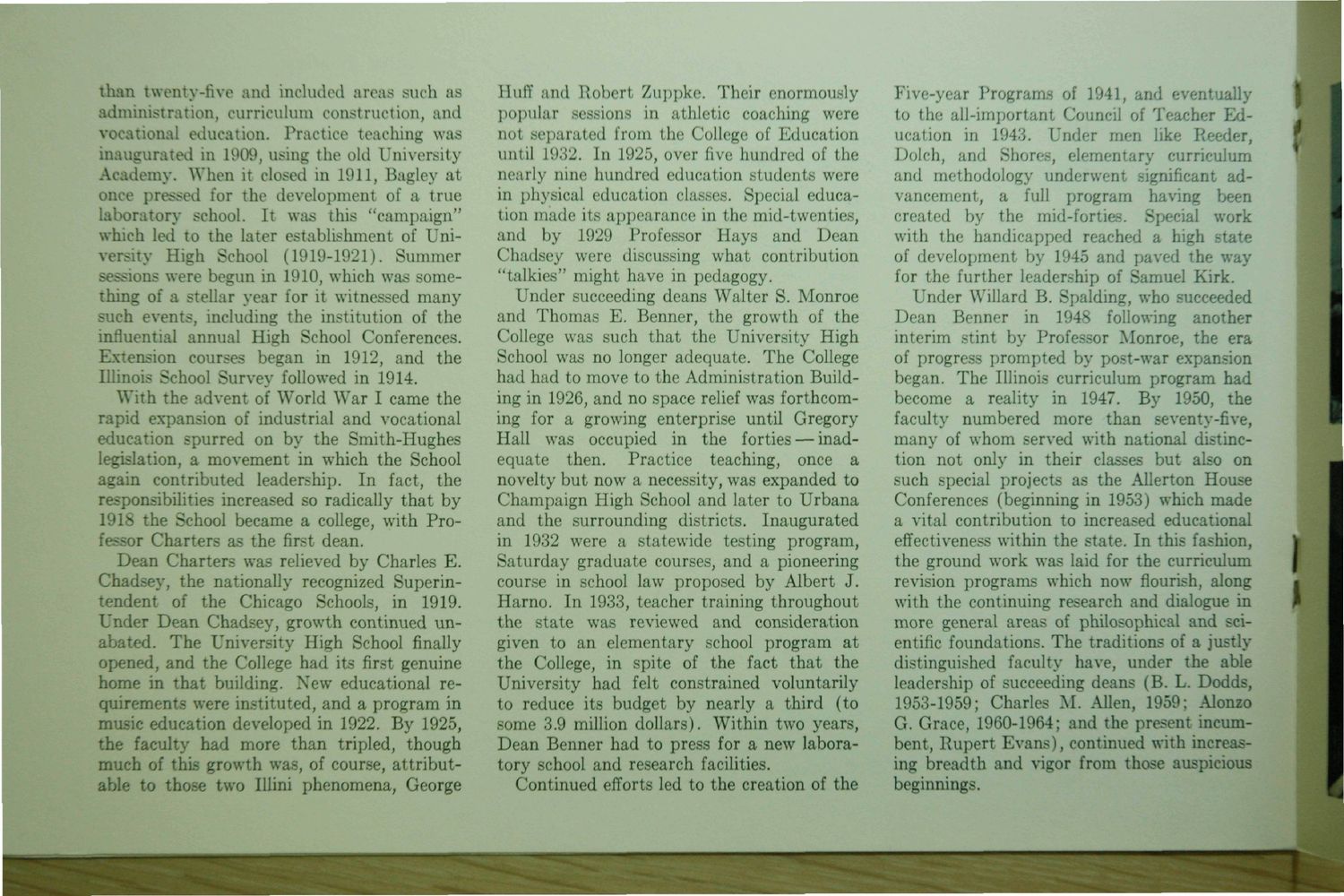| |
| |
Caption: Dedication - College of Education Dedication
This is a reduced-resolution page image for fast online browsing.

EXTRACTED TEXT FROM PAGE:
than twenty-five and included areas such as administration, curriculum construction, and vocational education. Practice teaching was inaugurated in 1909, using the old University Academy. When it closed in 1911, Bagley at once pressed for the development of a true laboratory school. It was this "campaign" which led to the later establishment of University High School (1919-1921). Summer sessions were begun in 1910, which was something of a stellar year for it witnessed many such events, including the institution of the influential annual High School Conferences. Extension courses began in 1912, and the Illinois School Survey followed in 1914. With the advent of World War I came the rapid expansion of industrial and vocational education spurred on by the Smith-Hughes legislation, a movement in which the School again contributed leadership. In fact, the responsibilities increased so radically that by 1918 the School became a college, with Professor Charters as the first dean. Dean Charters was relieved by Charles E. Chadsey, the nationally recognized Superintendent of the Chicago Schools, in 1919. Under Dean Chadsey, growth continued unabated. The University High School finally opened, and the College had its first genuine home in that building. New educational requirements were instituted, and a program in music education developed in 1922. By 1925, the faculty had more than tripled, though much of this growth was, of course, attributable to those two Illini phenomena, George Huff and Robert Zuppke. Their enormously popular sessions in athletic coaching were not separated from the College of Education until 1932. In 1925, over five hundred of the nearly nine hundred education students were in physical education classes. Special education made its appearance in the mid-twenties, and by 1929 Professor Hays and Dean Chadsey were discussing what contribution "talkies" might have in pedagogy. Under succeeding deans Walter S. Monroe and Thomas E. Benner, the growth of the College was such that the University High School was no longer adequate. The College had had to move to the Administration Building in 1926, and no space relief was forthcoming for a growing enterprise until Gregory Hall was occupied in the forties — inadequate then. Practice teaching, once a novelty but now a necessity, was expanded to Champaign High School and later to Urbana and the surrounding districts. Inaugurated in 1932 were a statewide testing program, Saturday graduate courses, and a pioneering course in school law proposed by Albert J. Harno. In 1933, teacher training throughout the state was reviewed and consideration given to an elementary school program at the College, in spite of the fact that the University had felt constrained voluntarily to reduce its budget by nearly a third (to some 3.9 million dollars). Within two years, Dean Benner had to press for a new laboratory school and research facilities. Continued efforts led to the creation of the Five-year Programs of 1941, and eventually to the all-important Council of Teacher Education in 1943. Under men like Reeder, Dolch, and Shores, elementary curriculum and methodology underwent significant advancement, a full program having been created by the mid-forties. Special work with the handicapped reached a high state of development by 1946 and paved the way for the further leadership of Samuel Kirk. Under Willard B. Spalding, who succeeded Dean Benner in 1948 following another interim stint by Professor Monroe, the era of progress prompted by post-war expansion began. The Illinois curriculum program had become a reality in 1947. By 1950, the faculty numbered more than seventy-five, many of whom served with national distinction not only in their classes but also on such special projects as the AHerton House Conferences (beginning in 1953) which made a vital contribution to increased educational effectiveness within the state. In this fashion, the ground work was laid for the curriculum revision programs which now flourish, along with the continuing research and dialogue in more general areas of philosophical and scientific foundations. The traditions of a justly distinguished faculty have, under the able leadership of succeeding deans (B. L. Dodds, 1953-1959; Charles M. Allen, 1959; Alonzo G. Grace, 1960-1964; and the present incumbent, Rupert Evans), continued with increasing breadth and vigor from those auspicious beginnings.
| |